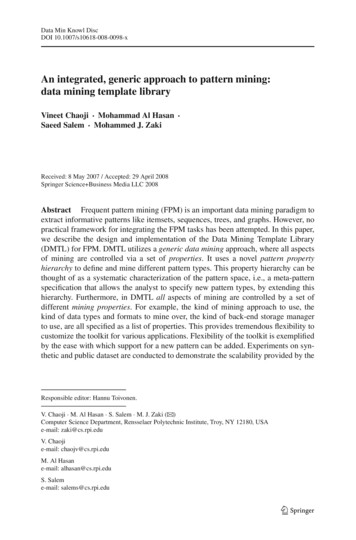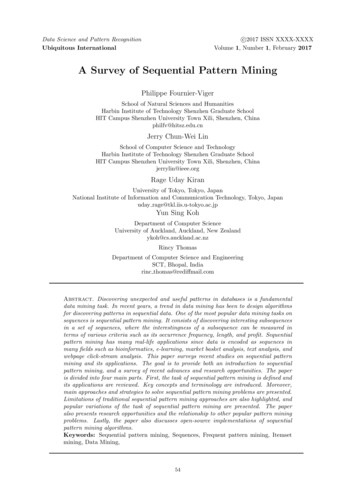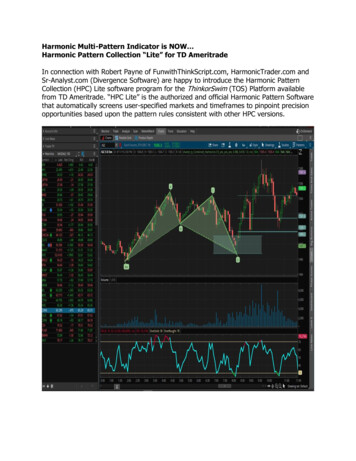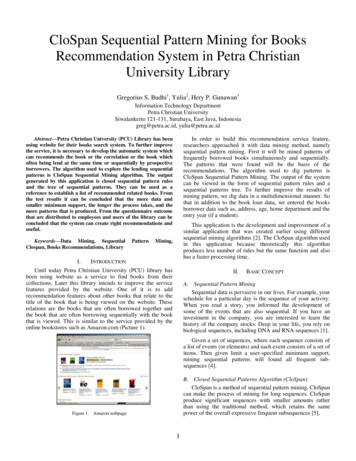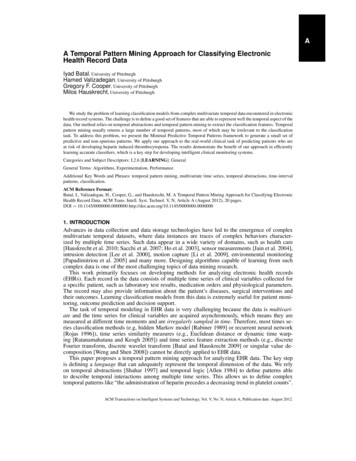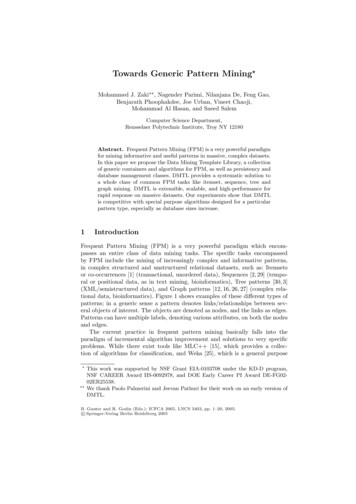
Transcription
Towards Generic Pattern Mining Mohammed J. Zaki , Nagender Parimi, Nilanjana De, Feng Gao,Benjarath Phoophakdee, Joe Urban, Vineet Chaoji,Mohammad Al Hasan, and Saeed SalemComputer Science Department,Rensselaer Polytechnic Institute, Troy NY 12180Abstract. Frequent Pattern Mining (FPM) is a very powerful paradigmfor mining informative and useful patterns in massive, complex datasets.In this paper we propose the Data Mining Template Library, a collectionof generic containers and algorithms for FPM, as well as persistency anddatabase management classes. DMTL provides a systematic solution toa whole class of common FPM tasks like itemset, sequence, tree andgraph mining. DMTL is extensible, scalable, and high-performance forrapid response on massive datasets. Our experiments show that DMTLis competitive with special purpose algorithms designed for a particularpattern type, especially as database sizes increase.1IntroductionFrequent Pattern Mining (FPM) is a very powerful paradigm which encompasses an entire class of data mining tasks. The specific tasks encompassedby FPM include the mining of increasingly complex and informative patterns,in complex structured and unstructured relational datasets, such as: Itemsetsor co-occurrences [1] (transactional, unordered data), Sequences [2, 29] (temporal or positional data, as in text mining, bioinformatics), Tree patterns [30, 3](XML/semistructured data), and Graph patterns [12, 16, 26, 27] (complex relational data, bioinformatics). Figure 1 shows examples of these different types ofpatterns; in a generic sense a pattern denotes links/relationships between several objects of interest. The objects are denoted as nodes, and the links as edges.Patterns can have multiple labels, denoting various attributes, on both the nodesand edges.The current practice in frequent pattern mining basically falls into theparadigm of incremental algorithm improvement and solutions to very specificproblems. While there exist tools like MLC [15], which provides a collection of algorithms for classification, and Weka [25], which is a general purpose This work was supported by NSF Grant EIA-0103708 under the KD-D program,NSF CAREER Award IIS-0092978, and DOE Early Career PI Award DE-FG0202ER25538.We thank Paolo Palmerini and Jeevan Pathuri for their work on an early version ofDMTL.B. Ganter and R. Godin (Eds.): ICFCA 2005, LNCS 3403, pp. 1–20, 2005.c Springer-Verlag Berlin Heidelberg 2005
2M.J. Zaki et al.Java library of different data mining algorithms including itemset mining, thesesystems do not have an unifying theme or framework, there is little database support, and scalability to massive datasets is questionable. Moreover, these toolsare not designed for handling complex pattern types like trees and graphs.Our work seeks to address all of the above limitations. In this paper we describe Data Mining Template Library (DMTL), a generic collection of algorithmsand persistent data structures, which follow a generic programming paradigm[4].DMTL provides a systematic solution for the whole class of pattern mining tasksin massive, relational datasets. The main contributions of DMTL are as follows:– Isolation of generic containers which hold various pattern types from theactual mining algorithms which operate upon them. We define generic datastructures to handle various pattern types like itemsets, sequences, trees andgraphs, and outline the design and implementation of generic data miningalgorithms for FPM, such as depth-first and breadth-first search.– Persistent data structures for supporting efficient pattern frequency computations using a tightly coupled database (DBMS) approach.– Native support for both vertical and horizontal database formats for highlyefficient mining.– Developing the motivation to look for unifying themes such as right-mostpattern extension and depth-first search in FPM algorithms. We believe thisshall facilitate the design of a single generic algorithm applicable across awide spectrum of patterns.One of the main attractions of a generic paradigm is that the generic algorithms for mining are guaranteed to work for any pattern type. Each pattern ischaracterized by inherent properties that it satisfies, and the generic algorithmexploits these properties to perform the mining task efficiently. We conduct several experiments to show the scalability and efficiency of DMTL for differentpattern types like itemsets, sequences, trees and graphs. Our results indicatethat DMTL is competitive with the special purpose algorithms designed for aparticular pattern type, especially with increasing database sizes.2PreliminariesThe problem of mining frequent patterns can be stated as follows: Let N {x1 , x2 , . . . , xnv } be a set of nv distinct nodes or vertices. A pair of nodes (xi , xj )is called en edge. Let L {l1 , l2 , . . . , lnl }, be a set of nl distinct labels. Let Ln :N L, be a node labeling function that maps a node to its label Ln (xi ) li ,and let Le : N N L be an edge labeling function, that maps an edge to itslabel Le (xi , xj ) lk .It is intuitive to represent a pattern P as a graph (PV , PE ), with labeledvertex set PV N and labeled edge set PE {(xi , xj ) xi , xj PV }. Thenumber of nodes in a pattern P is called its size. A pattern of size k is calleda k-pattern, and the class of frequent k-patterns is referred to as Fk . In someapplications P is a symmetric relation, i.e., (xi , xj ) (xj , xi ) (undirected edges),
Towards Generic Pattern Mining3while in other applications P is anti-symmetric, i.e., (xi , xj ) (xj , xi ) (directededges). A path in P is a set of distinct nodes {xi0 , xi1 , xin }, such that (xij , xij 1 )in an edge in PE for all j 0 · · · n 1. The number of edges gives the lengthof the path. If xi and xj are connected by a path of length n we denote it asxi n xj . Thus the edge (xi , xj ) can also be written as xi 0 xj .Given two patterns P and Q, we say that P is a subpattern of Q (or Q isa super-pattern of P ), denoted P Q if and only if there exists a 1-1 mappingf from nodes in P to nodes in Q, such that for all xi , xj PV : i) Ln (xi ) Ln (f (xi )), ii) Le (xi , xj ) Le (f (xi ), f (xj )), and iii) (xi , xj ) PV iff (if andonly if) (f (xi ), f (xj )) QV . In some cases we are interested in embeddedsubpatterns. P is an embedded subpattern of Q if: i) Ln (xi ) Ln (f (xi )), iii)Le (xi , xj ) Le (f (xi ), f (Xj )), and iii) (xi , xj ) PE iff f (xi ) l f (xj ) for somel 0, i.e., f (xi ) is connected to f (xj ) on some path. If P Q we say that P iscontained in Q or Q contains P .A database D is just a collection (a multi-set) of patterns. A database patternis also called an object. Let O {o1 , o2 , . . . , ono }, be a set of no distinct objectidentifiers (oid). An object has a unique identifier, given by the function O(di ) oj , where di D and oj O. The number of objects in D is given as D .The absolute support of a pattern P in a database D is defined as the numberof objects in D that contain P , given as π a (P, D) {P d d D} . Thea(P,D)(relative) support of P is given as π(P, D) π D . A pattern is frequent if itssupport is more than some user-specified minimum threshold, i.e., if π(P, D) π min . A frequent pattern is maximal if it is not a subpattern of any other frequentpattern. A frequent pattern is closed if it has no super-pattern with the samesupport. The frequent pattern mining problem is to enumerate all the patternsthat satisfy the user-specified π min frequency requirement (and any other userspecified conditions).The main observation in FPM is that the sub-pattern relation defines apartial order on the set of patterns. If P Q, we say that P is more general thanQ, or Q is more specific than P . The second observation used is that if Q is afrequent pattern, then all sub-patterns P Q are also frequent. More importantis the converse, i.e. if P is infrequent and P Q then Q shall also be infrequent(follows from the anti-monotonicity of frequency). The different FPM algorithmsdiffer in the manner in with they search the pattern space.2.1FPM InstancesSome common types of patterns include itemsets, sequences, trees, and graphs,as shown in Figure 1. In fact, every pattern can be modeled as a graph; thenodes (xi ) are shown under each circle and the node labels (Ln (xi )) are showninside the circle, whereas edge labels have been omitted.In an itemset [1] no two nodes have the same label. Let V {x1 , x2 , · · · xk } bea node set such that Ln (xi ) Ln (xj ) for all xi , xj V , and Ln (xi ) Ln (xi 1 )for all 1 i k 1. There are several possible formulation of the itemsetpattern: i) vertex-only: An itemset pattern P is just a of vertices, i.e., PV Vand PE , this is shown in Figure 1, ii) linear: in another formulation the
4M.J. Zaki et al.SEQUENCE (A AB C)ITEMSET . 1. FPM Instancesitemset is defined as PV V , and PE {(xi , xi 1 ) xi , xi 1 PV }, iii) clique:A third alternative is to represent itemset P as a clique, i.e., PV V andPE {(xi , xj ) i j and xi , xj PV }.In sequence mining [2], a sequence is modeled as an ordered list of itemsets,and thus the different nodes in a sequence can have the same label. We canmodel a sequence pattern P as being made up of a sequence of n itemsets P i ,i 1, · · · n, using the linear formulation (as shown in Figure 1); note that usingthe vertex-only formulation is problematic, since it results in a disconnected npattern. Thus P has a vertex set made up of n disjoint subsets PV i 1 PVi .The edge set PE contains all the edges within P i (consecutive and undirected),and it also contains a directed edge for every pair of consecutive itemsets, i.e.,from the last node of P i to the first node of P i 1 .In tree mining [30, 3], typically rooted, ordered and labeled trees are considered. Thus a tree pattern P consists of the vertex set PV {r, x1 , x2 , · · ·}, wherer is a special node called root. A tree pattern must satisfy all tree properties,namely i) the root has no parent, i.e., (xi , r) PE for any xi PV , ii) the edgesare directed, i.e., if (xi , xj ) PE , then (xj , xi ) PE ), iii) a node has only oneparent, i.e., if (xi , xj ) PE , then (xk , xj ) PE for any xk xi , iv) the tree isconnected, i.e., for all xi PV , there exists a path from the root r to xi , and v)tree has no cycles. Furthermore for ordered trees the order of a nodes’ childrenmatters. This means that there is an ordering of edges in PE , such that (xi , xj )comes before (xi , xk ) in PE only if xj is before xk in the ordering of xi ’s children.Embedded trees can be defined by following the definition of embedded patternsintroduced earlier.Finally, by definition a pattern can model any general graph, as well as anyspecial constraints that might appear in graph mining [12, 16, 26], such as connected graphs, or induced subgraphs. It is also possible to model other patterns
Towards Generic Pattern Mining5such as DAGs (directed acyclic graphs). DMTL currently supports pattern mining of i) itemsets, ii) sequences, iii) embedded, rooted trees with ordered edgesand iv) induced, undirected graphs with no single loops or multiple edges. As weshall soon see, the toolkit can be extended to incorporate mining of other userdefined patterns as well.2.2Database FormatIn a typical FPM task, the database is in the horizontal format i.e. a set of transactions, where each transaction is an object of the pattern type being mined [1].Recently, vertical database formats have been proposed for mining itemsets, sequences and trees [28, 29, 30]. The vertical format is the more attractive alternative since it enables fast computation of supports by avoiding repeated databaseaccesses. It does so by associating an entity called Vertical Attribute Table, VATwith each pattern. For an itemset, the VAT is the list of tids in which it is contained; VATs for sequences and trees are more complex and are described later.There currently does not exist a vertical scheme for graphs; the introductionof a new and efficient VAT scheme for graphs is one of our main contributions.DMTL introduces two modes of persistency: i) the collection of frequent patternsitself may be too large to fit in main memory, and hence persistent containersare provided to hold them, and ii) persistent storage and access to VATs. Boththese modes of persistency are entirely transparent to the user.3DMTL: Data Structures and AlgorithmsThe C Standard Template Library (STL) provides efficient, generic implementations of widely used algorithms and data structures, which tremendouslyaid effective programming. Like STL, DMTL is a collection of generic data mining algorithms and data structures. In addition, DMTL provides persistent dataand index structures for efficiently mining any type of pattern or model of interest. The user can mine custom pattern types, by simply defining the new patterntypes, but the user need not implement a new algorithm - the generic DMTLalgorithms can be used to mine them. Since the mined models and patternsare persistent and indexed, this means the mining can be done efficiently overmassive databases, and mined results can be retrieved later from the persistentstore.Following the ideology of generic programming, DMTL provides a standardized, general, and efficient implementation of frequent pattern mining tasks byisolating the concept of data structures or containers, as they are called in genericprogramming, from algorithms. DMTL provides container classes for representing different patterns (such as itemsets and sequences) and collection of patterns, containers for database objects (horizontal and vertical), and containersfor temporary mining results. These container classes support persistency whenrequired.Generic algorithms, on the other hand are independent of the container andcan be applied on any valid container. These include algorithms for performing
6M.J. Zaki et al.intersections of the vertical lists [28, 29, 30] for itemsets, sequences or other patterns. Generic algorithms are also provided for mining itemsets, sequences andtrees [1, 20, 28, 29], as well as for finding the maximal or closed patterns [11, 31].Finally DMTL provides support for the database management functionality,pre-processing support for mapping data in different formats to DMTL’s nativeformats, as well as for data transformation (such as discretization of continuous values). It should be noted that some of the algorithms designed for theC STL were inherently generic i.e. independent of the underlying datatypeor container (e.g. sort). However devising a generic algorithm for FPM was asignificant design challenge; we present it in Figure 3.In this section we focus on the containers and algorithms for mining. In latersections we discuss the database support in DMTL as well as support for preprocessing and post-processing.Pattern FamilyPatFamTypepvectorplistPatternpartial orderPersistency ManagerPattern TypeItemsetSequenceTreeGraphFig. 2. DMTL Container Hierarchy3.1ContainersFigure 2 shows the different DMTL container classes for PMT (the PatternMining Toolkit) and the relationship among them. At the lowest level are thedifferent kinds of pattern-types one might be interested in mining. A pattern isa generic container instantiated for one of the pattern-types. There are severalpattern family types (such as pvector, plist, etc.) which together with a persistency manager class make up different pattern family classes. More details oneach class appears below.
Towards Generic Pattern Mining7Pattern. In DMTL a pattern is a generic container, which can be instantiated asan itemset, sequence, tree or a graph, specified as Pattern class P by meansof a template argument called Pattern-Type (P). A generic pattern is simply aPattern-Type whose frequency we need to determine in a larger collection ordatabase of patterns of the same type.Pattern-Type. A pattern type is the specific pattern to be mined, e.g. itemset,and in that sense is not a generic container. DMTL has the itemset, sequence,tree and graph pattern-types defined internally; however the users are free todefine their own pattern types, so long as the user defined class provides implementations for the methods required by the generic containers and algorithms.We shall later show how a new pattern type may be added to the library.Pattern Family. In addition to the basic pattern classes, most pattern miningalgorithms operate on a collection of patterns. The pattern family is a genericcontainer PatternFamily class PatFamType to store groups of patterns,specified by the template parameter PatFamType. PatFamType represents a persistent class provided by DMTL, that provides seamless access to the members,whether they be in memory or on disk.Pattern Family Type. This class provides the required persistency in storage and retrieval of patterns. DMTL provides several pattern family types tostore groups of patterns. Each such class is templatized on the pattern-type (P)and a persistency manager class PM. An example is pvector class P, classPM , a persistent vector class. It has the same semantics as a STL vector withadded memory management and persistency. Another class is plist P,PM . Instead of organizing the patterns in a linear structure like a vector or list, anotherpersistent family type DMTL class, partial-order P,PM , organizes the patterns according to the sub-pattern/super-pattern relationship. While pvector andpartial-order provide the same interface, certain operations will be more efficientin one class than the other. For example, inserts and deletions are cheaper forplists, while the maximality and closed testing functions will be cheaper forpartial-orders, since the patterns are already organized according to sub/superpattern relation.3.2Persistency Manager for PatternsAn important aspect of DMTL is to provide a user-specified level of persistencyfor all DMTL classes. To support large-scale data mining, DMTL provides automatic support for out-of-core computations, i.e., memory buffer management,via the persistency manager class PM. The PatternFamilyType class uses thepersistency manager (PM) to support the buffer management for patterns. Thedetails of implementation are hidden from PatternFamily; all generic algorithmscontinue to work regardless of whether the family is (partially) in memory or ondisk. The interface of a persistent container (like pvector) is similar to that ofa volatile container (like STL vector), hence encapsulating the implementation
8M.J. Zaki et al.behind the common interface. More details on the persistency manager will begiven later.3.3Generic Mining AlgorithmsThe pattern mining task can be viewed as a search over the pattern space lookingfor those patterns that match the minimum support constraint. For instancein itemset mining, the search space is the set of all possible subsets of items.Within DMTL we attempt to provide a unifying framework for the wide rangeof mining algorithms that exist today. Figure 3 shows the pseudo-code for thegeneric mining algorithm, which was devised by combining the unifying aspectsof mining itemsets, sequences, trees and graphs [28, 29, 30, 26]. Note that miningF2 (i.e., level-2) often creates performance and memory bottleneck in FPM tasks,hence we employ a preemptive horizontal scan to accumulate estimated supportsof level-2 patterns (line 3). This is an optimization intended for level-2 only, andwe use the vertical approach thereon. The extend routine outlines the importanttasks for mining any pattern: i) systematic candidate generation (line 8), ii)isomorphism checking (line 9) and iii) support counting which we accomplishthrough the vertical approach (lines 10-11). Partitioning frequent patterns intoequivalence classes leads to a Fk Fk candidate generation i.e. an Fk 1 candidateis generated by joining two Fk sized patterns. It should also be noted that forgraphs g Fk implies g has k edges (not k nodes). Some of the salient featuresof our algorithm’s design are:Search Strategy. Several variants exist, depth-first search (DFS) and breadthfirst search (BFS) being the primary ones. BFS has the advantage of providingbetter pruning of candidates but suffers from the cost of storing all of a givenlevel’s frequent patterns in memory. Recent algorithms for mining complex patterns like trees and graphs have focused on the DFS approach, hence it is thepreferred choice for our toolkit as well. Nevertheless, support for BFS mining ofitemsets and sequences is provided.Vertical Mining. It has been shown that efficient vertical mining typicallyoutperforms the horizontal approaches [28, 29, 30]. The vertical approach accomplishes fast support counting by intersection of VATs, thereby avoiding repeateddatabase accesses. Section 4 gives details of the support we provide for verticalas well as horizontal mining.Right-Most Extension. Recent algorithms towards solving tree and graphmining [30, 26] have focused on an approach of right-most extension i.e. a newnode is added to the pattern only on the right most path from the root. Thismethod has been shown to exhaustively enumerate all candidates for trees andgraphs, and we believe that it can be augmented to work for itemsets and sequences as well. Though in the current framework the extension strategy is aninternal component of each pattern’s specialized routine, part of the proposed future work is devising a completely generic pattern mining algorithm, leveraging
Towards Generic Pattern Mining9aspects such as right most extension and depth-first search which are commonacross a wide range of patterns. We believe that developing the motivation tolook for such unifying themes in pattern mining is one of the key contributionsof this toolkit.DMTL provides generic algorithms encapsulating these search strategies; bytheir definition these algorithms can work on any type of pattern: Itemset, Sequence, Tree or Graph. An example is the generic algorithm DFS-Mine classPatFamType (PatternFamily PatFamType &pf, DB &db, .),whichmines the frequent patterns using a depth-first search (DFS) [28, 29]. The DFSalgorithm in turn relies on other generic subroutines for creating equivalenceclasses, for generating candidates, and for support counting. There is also ageneric BFS-Mine that performs Breadth-First Search [1, 20] over the patternspace.dfs1.2.3.4.5.6.7.mine (DB,result pats):F1 {level-1 frequent patterns}result pats result pats F1F2 {optimized mining of level-2 patterns}result pats result pats F2F2 {partition F2 into equivalence classes}for each equivalence class [P ]1 in F2 doextend(DB, result pats, [P ]1 )extend (DB, result pats, [P ])://DFS, equivalence class-based extension6. Fk 1 7. patterns Pi , Pj [P ] such that i j8.new pat PiPj //generate new candidate9.if new pat.canonical code is minimal then//candidate has passed isomorphism test10.new pat.vat Pi .vat Pj .vat //vat intersection11.if new pat.vat minsup then //new pat is frequent12.result pats results pat new pat13.Fk 1 Fk 1 new pat14. Fk 1 {partition Fk 1 into equivalence classes}15. for each equivalence class [P ]k in Fk 1 do16.extend(DB, result pats, [P ]k )Fig. 3. Generic DFS Pattern MiningFigure 3 seeks to illustrate the major steps of DFS-Mine, our equivalence classbased vertical mining algorithm. The toolkit employs templates to provide forefficient compile time polymorphism based on the pattern type: the underlyingalgorithm stays the same but each distinct pattern has its specialized implementation of the key steps. For instance, the isomorphism check in line 9 is necessaryonly for graphs, and is omitted for other simpler patterns. Isomorphism checking
10M.J. Zaki et al.is achieved through the canonical code member of each pattern. Each graph hasa canonical code representation, and an ordering is defined on the code suchthat among all isomorphic graphs only one has the the least canonical code; allother graphs shall be discarded at line 9. DMTL applies the DFS minimal codeof gSpan [26] but is not constrained by the choice of the canonical code. It is alsoto be noted that the equivalence class partitioning is omitted for graphs sinceFk F1 candidate generation does not lend itself easily to equivalence partitions.3.4Candidate Generation We now provide a brief review of our extension routine ( ) for the four primarypattern types, details of the VAT intersection follow later.Itemset: Itemset join is the simplest and DMTL employs a vertical miningapproach based on [28]. The join operation is defined on two itemsets P x andP y, belonging to the same equivalence class, [P ], which yields P xy [Px ].Sequence: An equivalence class of sequences can comprise members which aresequence atoms (P X) or event atoms (P Y ). As described in [29], a joinof two sequences within the same equivalence class [P ] can lead to one of threepossibilities – i) joining P B with P D yields P BD (join of two event atoms); ii)join of P B with P A results in P B A (join of event atom with sequenceatom) and iii) join of two sequence atoms, P A with P F leads to threeoutcomes: an event atom P AF and two sequence atoms, P A F andP F A.Tree: An equivalence class of trees comprises members which share the commonprefix, but differing in the last node of the tree and the position where it isattached to the prefix. Hence members of the same equivalence class [P ] maybe denoted as pairs of (last node, position). A join of (x, i) with (y, j) leads tothe following possibilities: i) if i j add (y, j) and (y, ni )) to [Px ], where ni isthe depth-first number of node x; ii) if i j the new candidate is (y, j) in class[Px ]; and iii) no candidates are possible when i j. We refer the reader to [30]for elaboration on the prefix based representation scheme used for trees.Graph: To assist in systematic candidate generation and isomorphism testing,DMTL uses the ordering of vertex and edge labels to generate graphs from acore tree structure [26]. An Fk F1 join on graphs is a complex operation; ateach such extension a new edge is added to the given graph. Two types of edgeextensions are defined: a back edge which introduces a cycle, and a forward edgewhich adds a new node to the graph. See [26] for more details.3.5Isomorphism CheckingSince a graph encompasses other simpler patterns (itemset, sequence, tree) wedefine the isomorphism problem for graphs: a graph p is isomorphic to q if thereexists a mapping M : pv qv such that for all xi , xj p, Lp (xi ) Lq (M (xi ))
Towards Generic Pattern Mining11and (xi , xj ) pe iff (M (xi ), M (xj )) qe . It has been shown that for itemsets,sequences and ordered trees the isomorphism checking may be averted by intelligent candidate generation, e.g., for the case of itemsets, AB and BA areisomorphic, but the algorithm can avoid generating BA by joining an itemset Pionly with a lexicographically greater itemset Pj (where both belong to the equivalence class [P ]). Such schemes exist for sequences and ordered trees as well, butmore complex patterns like unordered trees, free trees, directed acyclic graphs(DAGs) and generic graphs shall require some form of isomorphism testing.Isomorphism Checking in Graphs: We follow the scheme outlined in [26]to achieve isomorphism checking for graphs. Based on a linear order on vertexand edge labels, a unique depth-first traversal is defined for any given graph.Each vertex in the graph is assigned a depth-first id, which is its order in thedepth-first traversal. Each edge is represented by a 5-tuple (i, j, li , lij , lj ) wherei is the DFS id of the first vertex of the edge and j of the second one, and li ,lij and lj are labels of the first vertex, the edge and second vertex respectively.Isomorphism checking is accomplished by defining an order on such 5-tuples.4DMTL: Persistency and Database SupportDMTL employs a back-end storage manager that provides the persistency andindexing support for both the patterns and the database. It supports DMTLby seamlessly providing support for memory management, data layout, highperformance I/O, as well as tight integration with database management systems (DBMS). It supports multiple back-end storage schemes including flat files,embedded databases, and relational or object-relational DBMS. DMTL also provides persistent pattern management facilities, i.e., mined patterns can themselves be stored in a pattern database for retrieval and interactive exploration.DMTL provides native database support for both the horizontal [1] and vertical [28, 29, 30] data formats. It is also worth noting that since in many cases thedatabase contains the same kind of objects as the patterns to be extracted (i.e.,the database can be viewed as a pattern family), the same database functionalityused for horizontal format can be used for providing persistency for pattern families. It is relatively straightforward to store a horizontal format object, and byextension, a family of such patterns, in any object-relational database. Thus thepersistency manager for pattern families can handle both the original databaseand the patterns that are generated while mining. DMTL provides the requiredbuffer management so that the algorithms continue to work regardless of whetherthe database/patterns are in memory or on disk.4.1Vertical Attribute TablesTo provide native database support for objects in the vertical format, DMTLadopts a fine grained data model, where records are stored as Vertical AttributeTables (VATs). Given a database of objects, where each object is characterizedby a set of properties or attributes, a VAT is essentially the collection of objects
12M.J. Zaki et al.that share the same values for the attributes. For example, for a relational table, cars, with the two attributes, color and brand, a VAT for the propertycolor red stores all the transaction identifiers of cars wh
for mining informative and useful patterns in massive, complex datasets. In this paper we propose the Data Mining Template Library, a collection of generic containers and algorithms for FPM, as well as persistency and database management classes. DMTL provides a systematic solution to a whole class of common FPM tasks like itemset, sequence .
